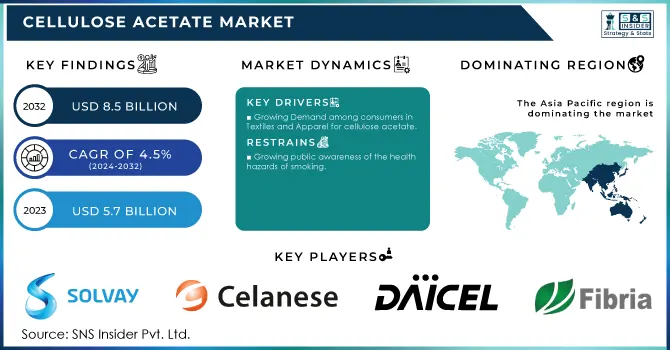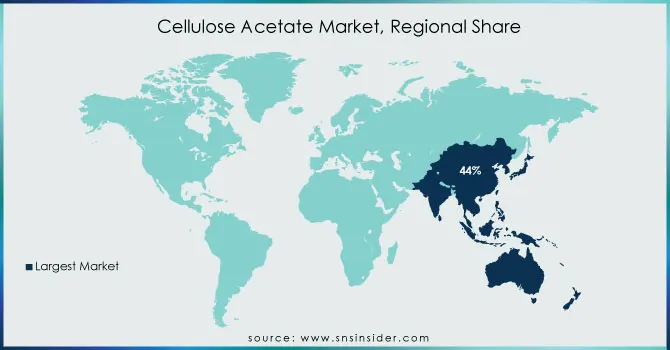Cellulose Acetate Market Report Scope & Overview:
The Cellulose Acetate Market Size was valued at USD 5.7 Billion in 2023. It is expected to grow to USD 8.5 Billion by 2032 and grow at a CAGR of 4.5% over the forecast period of 2024-2032.

Get more information on Cellulose Acetate Market - Request Sample Report
Cellulose acetate is one of the primary components present in the products made by the tobacco industry, and, significantly, its use is still substantial at the moment of tobacco’s declining popularity. A fact explaining this phenomenon is that the production of super-efficient filters for cigarettes is currently on the rise and is likely to continue on the same course. Various countries are also stepping up their cigarette health and environmental requirements, and the making of highly effective cigarette filters capable of trapping any number of toxic particles and significantly decreasing the number of toxins inhaled by the smoker can soon become standard as far as cigarette production is concerned. A change in the market’s ecological orientation also plays a role in the account of the fact that tobacco producers will also follow the growing trend of being environment-friendly and producing biodegradable filters for their cigarettes. Thus, although, indeed, tobacco consumption is now in decline, the amount of cellulose acetate consumed is continuously increasing in any market related to this product.
In the European Union, Directive 2014/40/EU mandates that cigarette filters must meet specific performance criteria to reduce harmful emissions such as tar, nicotine, and carbon monoxide. This regulation has prompted tobacco companies to develop advanced cellulose acetate filters that can better trap toxic particles and comply with health standards.
Cellulose acetate material having a significant impact on the medical and pharmaceutical sectors is cellulose acetate. Owing to its biocompatible and versatile properties, as well as its safety, it is being applied increasingly in the analyses. For instance, cellulose acetate fabricates drug delivery systems. Such controlled-release products are designed to enhance the treatment’s effectiveness, ensure exact delivery, minimize the dose administered to patients, and maintain a constant level of the drug in the bloodstream. Meanwhile, products based on cellulose acetate such as wound dressings are in growing demand. They can absorb moisture well, create a favorable wound-healing medium, and cause no inconvenience to the patients.
Furthermore, the novel cellulose acetate fabricates dialysis membranes. They are very permeable and selective, which makes it possible to purify the blood as efficiently as possible. Due to the growing needs of the population in terms of health conditions, this attribute contributes to its appropriation in the medical sphere. According to the U.S. Centers for Medicare & Medicaid Services (CMS), dialysis treatments alone accounted for over USD 114 billion in healthcare spending in 2021, reflecting the growing demand for high-performance medical materials like cellulose acetate.
Cellulose Acetate Market Dynamics
Drivers
- Growing Demand among consumers in Textiles and Apparel for cellulose acetate.
- Increasing focus on sustainability and alternatives in the market.
Cellulose acetate is becoming more and more common in the textile and apparel industry, due to its unique combination of style, sustainability, and affordability. It is as exotic in appearance as high-quality fashion clothes should be. It facilitates environmentally compatible and nature-friendly living. It enables looking into the future with confidence, to survive without destroying nature. This peculiar material has abundant benefits rather than mere favor. It has a rich sheen and cottony-soft feel fashionable for high-quality dresses, blouses, and linings. Durable in wet conditions, resistant to creasing, and washable, cellulose acetate offers the fashionable look of luxurious fabrics. It contains the natural cellulose used as the only raw material. Nowadays, society is experiencing an increasing demand for nature-friendly products. To rise in this trend, this material is in broad demand, as it is renewable, as compared with other materials. As a further advantage, cellulose acetate offers the wear comfort and styling ease.
According to the European Union’s Circular Economy Action Plan, textile waste accounts for nearly 5.8 million tons of waste in the EU annually, and the shift towards biodegradable and renewable materials like cellulose acetate is seen as a key step in reducing environmental impacts.
Restraint
- Growing public awareness of the health hazards of smoking.
- The Decline of Photographic Film in the cellulose acetate market.
The decline of photographic film has had a cascading effect on various industries, and the cellulose acetate market is no exception. Cellulose acetate was once a prominent material used in film bases, but the shift toward digital photography has significantly reduced this application. With the reduction in film cameras being manufactured and used, the demand for film base, including cellulose acetate, plummeted. This significantly reduced the market share of cellulose acetate in this application. Major film producers reduced or ceased production, contributing to a significant contraction in this segment of the cellulose acetate market. Once a dominant application for the material, its market share has diminished as the photographic industry has transitioned to digital technologies, leaving the cellulose acetate market to pivot toward other growing applications, such as textiles, cigarette filters, and biodegradable plastics.
Opportunity
- Growing demand for cellulose acetate in the 3D printing market
- Developing environmentally friendly packaging solutions with the use of Cellulose acetate.
The future of cellulose acetate is bright, brimming with possibilities beyond its current uses, cellulose acetate become a game-changer in 3D printing. Ongoing studies are investigating its potential in this rapidly evolving field. Cellulose acetate can be processed into filaments suitable for 3D printing. These filaments offer a significant advantage – they are biodegradable! This translates to printed products that decompose naturally at the end of their lifespan, reducing environmental impact compared to traditional non-biodegradable materials commonly used in 3D printing, like ABS plastic.
Cellulose Acetate Market Segmentation
By Type
The fiber segment held the largest market share around 64% in 2023. This dominance can be attributed to the surging demand for fiber-based cellulose acetate in the textile industry. This material is widely used in a variety of consumer goods, including apparel, carpets, linings, umbrellas, furniture, felts, and even cigarette filters. Cellulose acetate fiber stands out as a prominent synthetic fiber prized for its beautiful drape and affordability. Furthermore, staple acetate fibers, with their wool-like qualities, serve as a cost-effective substitute for wool in various knitwear and luxury fabrics. This widespread adoption in textiles is expected to propel the fiber segment's growth in the coming years.
By Application
The Cigarette filters held the largest market share around 38% in 2023. This dominance is projected from cellulose acetate's exceptional filtering properties and its eco-friendly nature as a biodegradable material in the Cellulose Acetate Market. The increasing number of smokers in developing countries like India and China presents a potential growth opportunity for the cigarette filter segment. The increasing number of smokers in developing countries like India and China presents a potential growth opportunity for the cigarette filter segment.
Cellulose Acetate Market Regional Analysis
The Asia Pacific region held the largest market share around 44% in 2023. This dominance is driven by several factors increasing the use of cellulose acetate in various applications, including cigarette filters, textiles & apparel, photographic films, and tapes & labels, fuels market expansion. Strong government initiatives and ongoing infrastructure projects provide a tailwind for the APAC market. The major markets in the Asia-Pacific region are China and India as there is a rapid industrialization and urbanization process which resulted in an increased demand for textiles, packaging, and consumer goods. The Indian Ministry of Textiles reported that the Indian textiles and apparel industry would reach USD223 billion by 2021, positively impacting the demand for cellulose acetate. By focusing on environmental safety, the industry focused on developing biodegradable traits to replace synthetic plastics
Europe secures the second-largest market share, primarily driven by the robust demand from its thriving textile industry. Germany currently holds the top spot within Europe for cellulose acetate consumption, while the UK exhibits the fastest growth rate, suggesting promising potential for the future.

Get Customized Report as per your Business Requirement - Request For Customized Report
Key Manufacturers
-
Solvay (Acetate Filaments)
-
Celanese Corporation (Celanex)
-
Daicel Corporation (Celulose Acetato)
-
Accords Cellulosic Fibers Inc. (Accord Fiber)
-
China National Tobacco Corporation (Cigarette Filters)
-
SK Chemicals (Eco-Friendly Cellulose Acetate)
-
Sappi (Fibrilated Cellulose Acetate)
-
Rayonier Advanced Materials (Acetate Tow)
-
Sichuan Push Acetate Co. Ltd. (Push Acetate)
-
Borregaard (Lignin-Based Cellulose Acetate)
-
Eastman Chemical Company (Eastman Acetate)
-
Mitsubishi Chemical Holdings (Mitsubishi Acetate)
-
Acordis (Acordis Acetate)
-
Fibria (Fibria Acetate)
-
Kaneka Corporation (Kaneka Acetate)
-
Georgia-Pacific (GP Acetate)
-
PUC-Rio (PUC Acetate)
-
Juken Technology (Juken Acetate)
-
Jushi Group (Jushi Acetate)
-
Braskem (Braskem Acetate)
Key Users in End -Use Industry
-
H&M
-
Zara (Inditex)
-
Philip Morris International
-
British American Tobacco
-
Japan Tobacco International
-
Johnson & Johnson
-
Pfizer
-
Baxter International
Recent Development:
-
In August 2023, Eastman Chemical Company, a key player in cellulose acetate production, revealed plans to develop a new, specialized grade of this material. This innovation is expected to hit the market in 2024, offering a material specifically formulated for 3D printing applications.
-
In November 2022, Celanese Corporation, a U.S. materials leader, acquired DuPont de Nemours Inc.'s Mobility & Materials division for USD11 billion. This acquisition allows Celanese to streamline its offerings and focus resources on high-growth sectors. While DuPont, another U.S. chemical company, remains a prominent player in cellulose acetate production, this divestiture reflects their evolving focus.
| Report Attributes | Details |
|---|---|
| Market Size in 2023 | US$ 5.7 Billion |
| Market Size by 2032 | US$ 8.5 Billion |
| CAGR | CAGR of 4.5% From 2024 to 2032 |
| Base Year | 2023 |
| Forecast Period | 2024-2032 |
| Historical Data | 2020-2022 |
| Report Scope & Coverage | Market Size, Segments Analysis, Competitive Landscape, Regional Analysis, DROC & SWOT Analysis, Forecast Outlook |
| Key Segments | •By Type (Plastics, Fiber) •By Application (Cigarette Filters, Tapes & Labels, Textiles & Apparel, Photographic Films, Others) |
| Regional Analysis/Coverage |
North America (US, Canada, Mexico), Europe (Eastern Europe [Poland, Romania, Hungary, Turkey, Rest of Eastern Europe] Western Europe] Germany, France, UK, Italy, Spain, Netherlands, Switzerland, Austria, Rest of Western Europe]), Asia Pacific (China, India, Japan, South Korea, Vietnam, Singapore, Australia, Rest of Asia Pacific), Middle East & Africa (Middle East [UAE, Egypt, Saudi Arabia, Qatar, Rest of Middle East], Africa [Nigeria, South Africa, Rest of Africa], Latin America (Brazil, Argentina, Colombia Rest of Latin America |
| Company Profiles | Cerdia International GmbH, Sichuan Push Acetati Co Ltd, Rayonier Advanced Materials, Inc, Eastman Chemical Company, Celanese Corporation, Mitsubishi Chemical Holdings Corporation, China National Tobacco Corporation, Sappi Ltd, Rotuba Extruders, Inc, Daicel Corporation |
| Drivers | •Growing Textile and Apparel Industry Demand •Application of Technological Advancements •Growing Uses of Biodegradable Plastic in a Range of Industries |
| Restraints | •Declining Demand for Products in Markets Like Photographic Films and Cigarette Filters |

